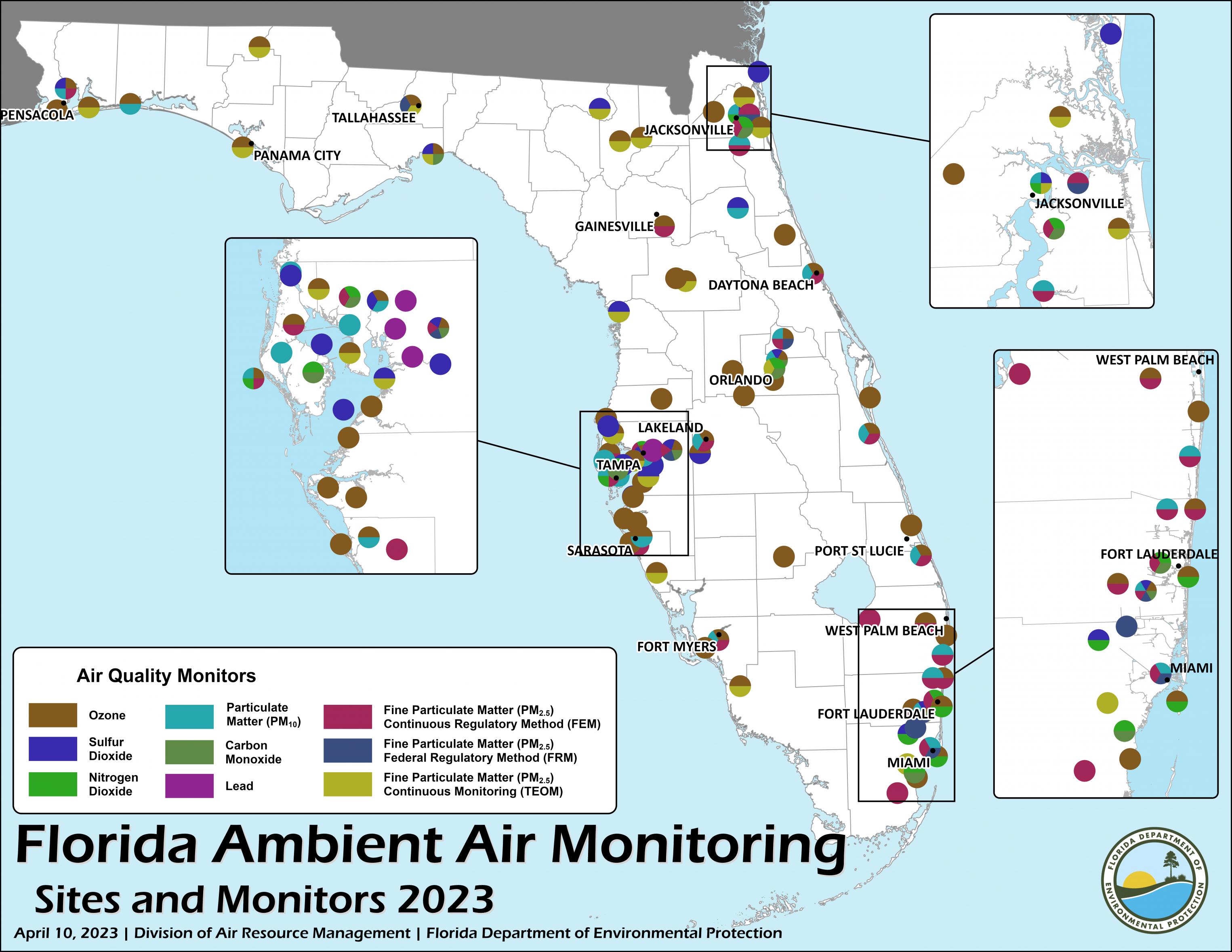What agencies and monitors make up Florida's ambient air monitoring network?
The Florida Department of Environmental Protection (DEP) along with local governmental agencies own and operate the monitors that make up Florida's ambient air monitoring network. The network is operated by DEP’s Division of Air Resource Management staff in Tallahassee, DEP's six district offices, and nine local governmental agencies (Broward, Hillsborough, Manatee, Miami-Dade, Orange, Palm Beach, Pinellas and Sarasota counties and the city of Jacksonville).
What are the measured levels of air pollutants in Florida?
Florida's air quality is driven by ozone (O3) and fine particles (particle pollution 2.5 or particulate matter 2.5 or PM2.5). To a lesser extent, it is also affected by carbon monoxide (CO), nitrogen dioxide (NO2), particle pollution 10 (particulate matter 10 or PM10) and sulfur dioxide (SO2). The levels for these pollutants can be found on the Air Quality Today webpage, which features the Florida Spatial Air Quality System (SAQS).
What is the air quality where I live?
This website contains many tools for reviewing air quality across the state of Florida. Access to these tools and the hourly data in tabular form for CO, NO2, O3, continuously monitored PM2.5 and PM10 and SO2 with summary information can be found on the Florida's Air Quality System (FLAQS) webpage.
Where can I find particle pollution data on which regulatory decisions are made?
Continuously monitoring PM2.5 samplers report data to this website but are not used for regulatory decisions. PM2.5 data for the regulatory network is collected on manually run samplers with filters that are exposed for 24 hours. PM10 data collected by both continuous and manual (filter-based) samplers are used for regulatory data. This website displays the continuously collected PM10 data only. The manually collected PM2.5 and PM10 data are not available in a timely fashion, but the summary statistics are updated quarterly and posted by year on the division's Annual Monitoring Reports webpage.
What is the Air Quality Index?
The Air Quality Index is a value that simplifies the CO, NO2, O3, particle pollution (PM10 and PM2.5) and SO2 concentrations and indicates the air quality in a certain location. More information may be found on the division's Air Quality Index webpage.
What are the current and historical Air Quality Index values where I live?
Today's Air Quality Index is available at the Air Quality Today webpage for all sites in Florida with ozone or continuous fine particle (PM2.5) monitors. The data displayed for the current day use the previous 24 hours for the PM2.5 calculations and the previous 31 hours for the eight-hour average ozone calculations. At midnight, the values for the day are left as calendar-day block averages.
This site provides up-to-the-hour information as well as historic information for the two pollutants that most commonly drive the Air Quality Index in Florida. The default settings display each of the ozone and PM2.5 monitor's Air Quality Index color code. To display either the Air Quality Index values or the concentration values, use radio buttons under the Layers tab on the left of the display of the map of Florida. The legend for the Air Quality Index is available on the Controls tab, also on the left of the display of the map of Florida.
Where can I find today's Air Quality forecasts?
Air quality forecasts provided by Florida's environmental agencies are available at the U.S. Environmental Protection Agency’s (EPA)'s AirNow website. Tomorrow's air quality forecast is also available at this site but generally not until after 4 p.m. Eastern time.
If you are having trouble viewing today's air quality index or tomorrow's forecast, click the Refresh button in your browser or (PC users) press the F5 key on your keyboard from the browser window displaying the PDF document. If you still experience any trouble viewing the documents, please contact the Division of Air Resource Management Help Desk.



